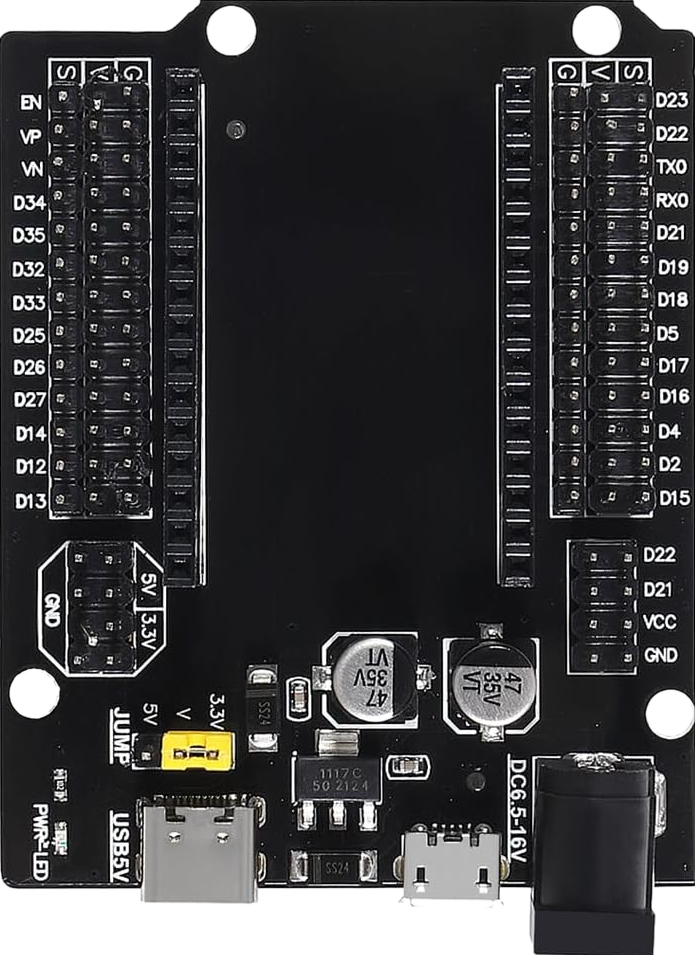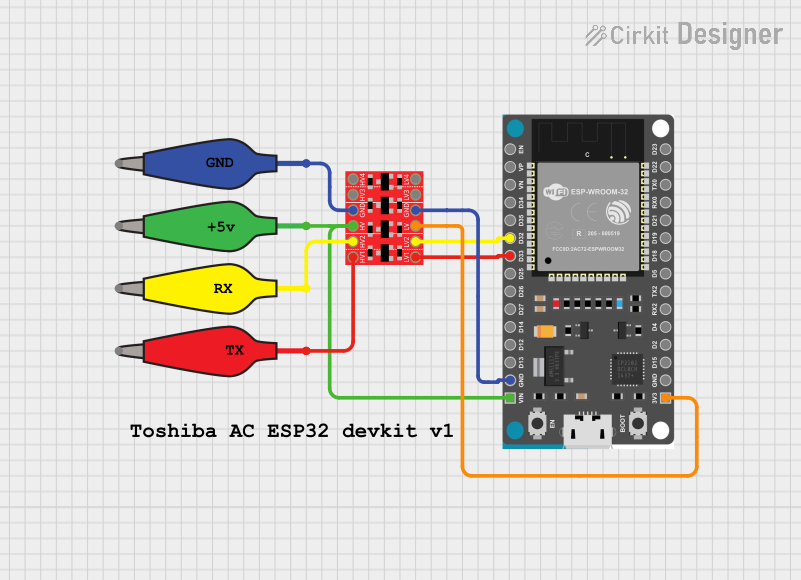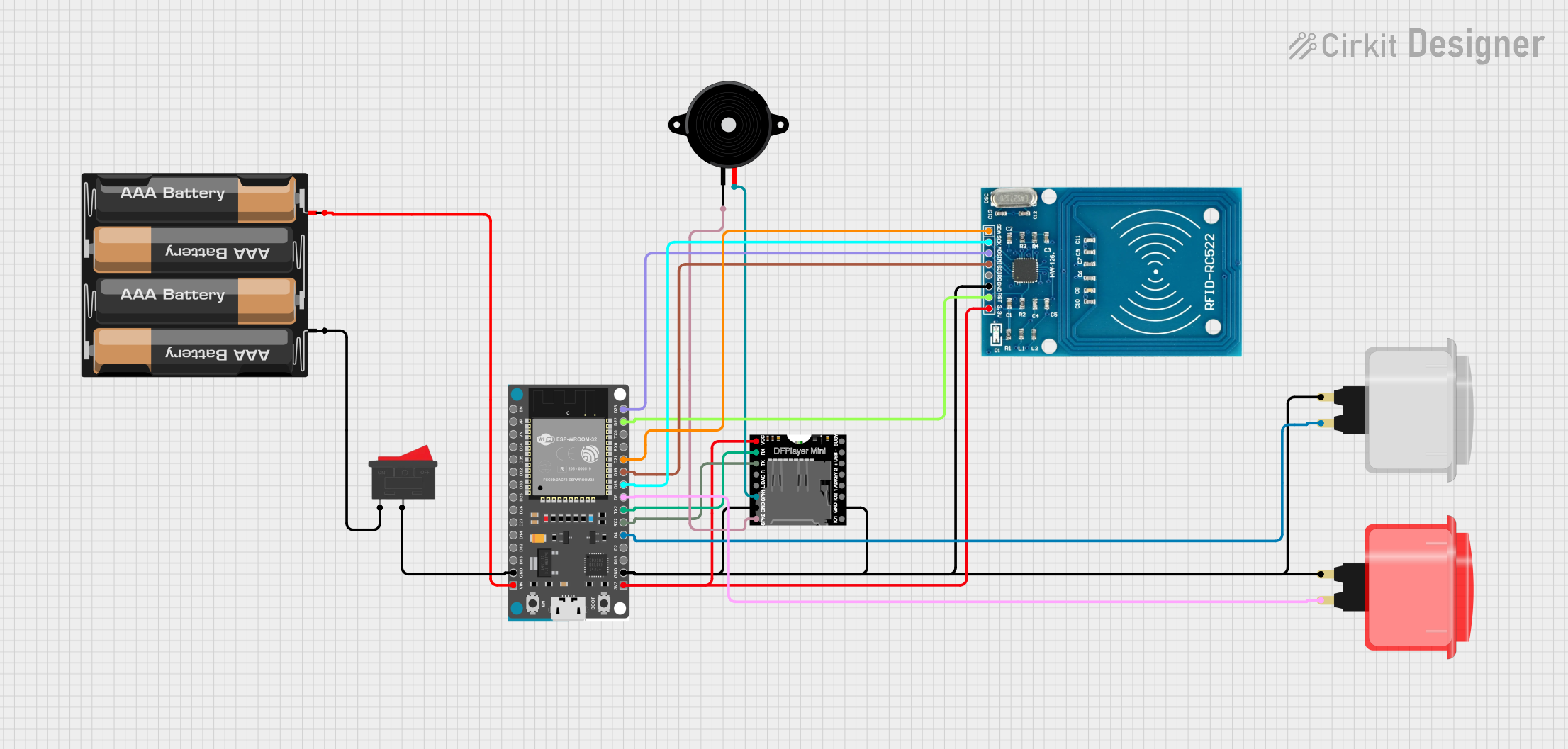
How to Use ESP-32 DEVKIT-V1 Expansion Board: Examples, Pinouts, and Specs

 Design with ESP-32 DEVKIT-V1 Expansion Board in Cirkit Designer
Design with ESP-32 DEVKIT-V1 Expansion Board in Cirkit DesignerIntroduction
The ESP-32 DEVKIT-V1 Expansion Board, manufactured by Espressif, is a versatile development board designed for IoT (Internet of Things) applications. It features the powerful ESP32 chip, which integrates Wi-Fi and Bluetooth capabilities, making it suitable for a wide range of wireless communication projects. This board is ideal for prototyping, smart home devices, wearable electronics, and other connected applications.
Explore Projects Built with ESP-32 DEVKIT-V1 Expansion Board

 Open Project in Cirkit Designer
Open Project in Cirkit Designer
 Open Project in Cirkit Designer
Open Project in Cirkit Designer
 Open Project in Cirkit Designer
Open Project in Cirkit Designer
 Open Project in Cirkit Designer
Open Project in Cirkit DesignerExplore Projects Built with ESP-32 DEVKIT-V1 Expansion Board

 Open Project in Cirkit Designer
Open Project in Cirkit Designer
 Open Project in Cirkit Designer
Open Project in Cirkit Designer
 Open Project in Cirkit Designer
Open Project in Cirkit Designer
 Open Project in Cirkit Designer
Open Project in Cirkit DesignerCommon Applications and Use Cases
- IoT devices and smart home automation
- Wireless sensor networks
- Wearable technology
- Robotics and remote control systems
- Data logging and monitoring systems
- Bluetooth-enabled applications
Technical Specifications
The ESP-32 DEVKIT-V1 Expansion Board is built around the ESP32 microcontroller, which offers high performance and low power consumption. Below are the key technical details:
Key Technical Details
| Parameter | Specification |
|---|---|
| Microcontroller | ESP32 Dual-Core Tensilica LX6 |
| Clock Speed | Up to 240 MHz |
| Flash Memory | 4 MB (varies by model) |
| SRAM | 520 KB |
| Wi-Fi Standard | 802.11 b/g/n |
| Bluetooth Standard | Bluetooth 4.2 (Classic and BLE) |
| Operating Voltage | 3.3V |
| Input Voltage (VIN) | 5V (via USB or VIN pin) |
| GPIO Pins | 30 (varies by board version) |
| ADC Channels | 18 |
| DAC Channels | 2 |
| Communication Interfaces | UART, SPI, I2C, I2S, PWM |
| Power Consumption | Ultra-low power (varies by mode) |
Pin Configuration and Descriptions
The ESP-32 DEVKIT-V1 Expansion Board has a 30-pin layout. Below is the pin configuration:
| Pin Number | Pin Name | Description |
|---|---|---|
| 1 | EN | Enable pin (active high) |
| 2 | IO23 | GPIO23, SPI MOSI |
| 3 | IO22 | GPIO22, I2C SCL |
| 4 | IO21 | GPIO21, I2C SDA |
| 5 | GND | Ground |
| 6 | VIN | Input voltage (5V) |
| 7 | IO19 | GPIO19, SPI MISO |
| 8 | IO18 | GPIO18, SPI SCK |
| 9 | IO17 | GPIO17, UART2 TX |
| 10 | IO16 | GPIO16, UART2 RX |
| ... | ... | ... (remaining pins follow similar format) |
Refer to the official datasheet for a complete pinout diagram.
Usage Instructions
How to Use the ESP-32 DEVKIT-V1 in a Circuit
Powering the Board:
- Connect the board to a computer or power source using a micro-USB cable.
- Alternatively, supply 5V to the VIN pin and connect GND to the ground.
Programming the Board:
- Install the Arduino IDE and add the ESP32 board support package.
- Select "ESP32 Dev Module" from the Tools > Board menu.
- Connect the board to your computer and select the appropriate COM port.
Connecting Peripherals:
- Use the GPIO pins to connect sensors, actuators, or other peripherals.
- Ensure that the voltage levels of connected devices are compatible with the 3.3V logic of the ESP32.
Uploading Code:
- Write your code in the Arduino IDE or another supported environment.
- Click the "Upload" button to flash the code to the ESP32.
Example Code: Blinking an LED
The following example demonstrates how to blink an LED connected to GPIO2:
// Define the GPIO pin where the LED is connected
const int ledPin = 2;
void setup() {
// Set the LED pin as an output
pinMode(ledPin, OUTPUT);
}
void loop() {
// Turn the LED on
digitalWrite(ledPin, HIGH);
delay(1000); // Wait for 1 second
// Turn the LED off
digitalWrite(ledPin, LOW);
delay(1000); // Wait for 1 second
}
Important Considerations and Best Practices
- Voltage Levels: Ensure that all connected peripherals operate at 3.3V logic levels. Use level shifters if necessary.
- Power Supply: Use a stable power source to avoid unexpected resets or malfunctions.
- GPIO Usage: Some GPIO pins have specific functions during boot (e.g., GPIO0, GPIO2). Avoid using these pins for critical peripherals.
- Heat Management: The ESP32 chip may heat up during operation. Ensure proper ventilation if used in enclosed spaces.
Troubleshooting and FAQs
Common Issues and Solutions
Board Not Detected by Computer:
- Ensure the USB cable is functional and supports data transfer.
- Install the correct USB-to-serial driver for your operating system.
Code Upload Fails:
- Check the selected COM port in the Arduino IDE.
- Press and hold the "BOOT" button on the board while uploading the code.
Wi-Fi Connection Issues:
- Verify the SSID and password in your code.
- Ensure the router is within range and supports 2.4 GHz Wi-Fi.
Random Resets or Instability:
- Check the power supply for stability.
- Avoid using GPIO pins with special boot functions for peripherals.
FAQs
Q: Can I power the board with a battery?
A: Yes, you can use a 3.7V LiPo battery connected to the 3.3V pin or a 5V source connected to the VIN pin.
Q: How do I use Bluetooth on the ESP32?
A: The ESP32 supports both Bluetooth Classic and BLE. Use the BluetoothSerial or BLE libraries in the Arduino IDE to implement Bluetooth functionality.
Q: What is the maximum number of GPIO pins I can use?
A: The ESP32 DEVKIT-V1 provides up to 30 GPIO pins, but some are reserved for specific functions. Refer to the pinout diagram for details.
Q: Can I use the ESP32 with MicroPython?
A: Yes, the ESP32 supports MicroPython. Flash the MicroPython firmware to the board and use a compatible IDE like Thonny.
By following this documentation, you can effectively utilize the ESP-32 DEVKIT-V1 Expansion Board for your IoT and embedded system projects.